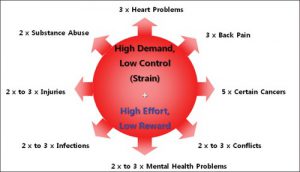I facilitate many large and small group discussions and always find that setting norms or…

The Cost of Doing Nothing
Many companies are willing to tackle the costs associated with improving the physical environment of their workplace. That’s partly because there is plenty of evidence to prove that the return on their investment will be substantial. These companies have developed sophisticated injury prevention programs to reduce injuries and ill-health related to increasing safety and awareness. The result for these employers is lower workers’ compensation costs and a healthier bottom line.
Growing awareness, particularly over the last several years of the significant impact that psychological health and safety has on workplace productivity, employee engagement and organizational budgets has prompted employers to begin developing strategies to focus on improving psychological health in the workplace.
In 2008 Canadian WCB’s paid $7.67 billion in benefit payments, or an average of $24,845 per each new compensated time-loss injury or fatality.1 Statistics such as these help organizations recognize the value of providing a physically safe workplace and focus on reducing costs associated with accidents and injuries. Here are some statistics regarding psychological health and safety that indicate some of the costs to organizations:
- 1 in 5 Canadians will experience a mental health illness in his/her lifetime.1
- The leading cause of short-term and long-term disability in 2005 was mental health issues, including stress.1
- The Canadian Policy Research Networks estimates that stress-related absences cost Canadian employers about $3.5 billion each year.2
- Costs of lost productivity due to mental illness in Canadian businesses equal $11.1 billion per year.3
- Frequent conflicts with supervisors or colleagues, and high psychological and emotional job demands more than double the risk of being injured in an occupational accident (relative risk 2.5).4
The Benefits of Doing Something
In spite of the fact that stress and poor mental health are costing Canadian businesses billions, skeptical employers may still be concerned about the amount of effort and expense required to make improvements in these areas. What is the likely cost-benefit, or return on investment in trying to address problems related to a psychologically unhealthy work environment?
Again, the literature is encouraging. While there are often difficulties quantifying some of the results, there is growing evidence that the cost-benefit ratio ranges from $1.50 to $6.15 for every dollar invested 5. Many of the cost-benefit analyses published in literature are based on the return on investment of “wellness” programs only, meaning health promotion programs aimed at improving the personal health practices of employees. These programs are unlikely to have much effect on employees who work in a toxic work environment. The greatest gains are those that occur when health promotion programs are implemented in a psychologically healthy workplace, one that is already open, trusting, and supportive.
Major changes can be made in workplaces without significant investment. Shifting a supervisor’s management style to one that is more supportive, showing respect or asking for input from employees on problems that affect them doesn’t cost money. These actions and others can make significant changes to the workplace environment, and improve the psychological well-being of employees tremendously.
Here are seven steps suggested by Health Canada in their Workplace Health System document:
- Gain commitment
- Set up a committee
- Complete a needs assessment
- Analyze the health profile
- Develop a 3-5 year Health Plan
- Develop specific Action Plans
- Review and evaluate.
Fairness – The Missing Link
Recent research shows that while demand /control and effort/reward are powerful influences on the health of employees, the effect of these influences is multiplied when these workplace conditions are perceived as unfair, or indicative of the employer’s lack of respect for employees.6
A sense of fairness in the workplace is related to trust, which is key to working relations, high morale and productivity. Feelings associated with a sense of unfairness such as anger, depression and anxiety translate chemically into compromised immune systems, setting the stage for a variety of adverse physical and mental health outcomes. These feelings of unfairness magnify the effects of perceived stress on health.

In our difficult Alberta do-more-with-less philosophy, businesses cannot succeed without sometimes making high demands on employees and expecting a lot of sustained effort. Most employees can cope with very high demands if they are given appropriate control over the way they do their jobs, and can put out sustained high efforts if they feel appropriately rewarded, appreciated and supported. It is the fairness that counts – the balance between the stressors (demands and effort) and the satisfiers (control, rewards and support). This balance, which will be reflected in employees’ perception of fairness, is more important than the actual levels of demands and efforts required of employees.
Workplace Fairness West believes in supporting organizations who want to focus on physiological health and safety. We bring tools and skills to start the dialogue, assess the climate and develop an action plan for fairness.
- Human Resources and Skills Development Canada – Occupational Injuries and Diseases in Canada, 1996-2008: Injury Rates and Cost to the Economy
- Williams, and J. Normand, “Stress at Work,” Canadian Social Trends, no. 70 (August 2003). Statistics Canada, (2003). http://www.statcan.ca:8096/bsolc/english/bsolc?catno =11 008-X20030026621
- Center for the Study of Living Standards – Five Deaths a Day: Workplace Fatalities in Canada 1993-2005
- ENFORM, The safety association for Canada’s upstream oil and gas industry. Risk management of Young, New and Inexperienced Workers.
- Health & Safety Ontario – The Business Case for a Healthy Workplace
- R. Tyler, et al., Social Justice in a Diverse Society, (Boulder, Colorado: Westview Press/Harper Collins 1997).
More information on the Health Canada document (in association with the National Quality Institute) – Steps for creating a healthy workplace –




